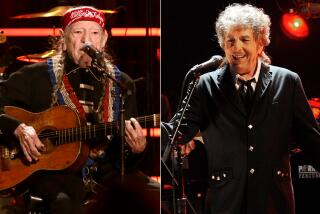COMMENTARY : A Satchmo Celebration at the Bowl
- Share via
Louis Armstrong, whose life will be commemorated by Wynton Marsalis and others tonight at the Hollywood Bowl, would have been 89 years old next Saturday. Born in such obscurity that even his true birthday was discovered only two years ago, he rose from dire poverty in New Orleans to become a symbol of the potential inherent in the most impoverished of black Americans and, most significantly, the prototype of jazz itself at a time when it was a ghettoized, often despised aspect of our culture. More than any of the few who preceded him or the many who followed, he fashioned the art of jazz improvisation.
To anyone who knows him only as a remote figure on a TV screen, singing “Hello, Dolly!” to Barbra Streisand or mugging through a comedy routine with Bing Crosby, Armstrong’s true significance must seem puzzling. When the origins of this music are examined, as they have been by Marsalis and other scholarly young men, his role comes more clearly into focus.
By the time he had paid early dues--studying at the Waifs’ Home in New Orleans, developing his style as a sideman with King Oliver, his mentor, and with the Fletcher Henderson band--Armstrong was able to fashion a persona that brought an unprecedented purity of sound, an uncomplicated yet eloquent way of interpreting the blues and other basic forms. In recordings by his Hot Five and other small groups, mostly with Earl Hines at the piano, he created a series of masterpieces that would be remembered throughout this century.
Of these, “West End Blues” (still with us on a CD) is by far the best known. With its carefully planned deepening of intensity, Armstrong’s impassioned wordless vocal interlude, masterful Hines solo and triumphant trumpet climax, this turned out to be the record that converted innumerable listeners all over the world to the music (among them this writer, in London, who would not be part of the jazz world today had he not heard it). As recently as 1985 the brilliant young trumpeter Jon Faddis recorded an almost note-by-note re-creation of “West End Blues.”
No matter how complex jazz became, there was a germ of Armstrong in everyone who followed. Of those who will perform tonight, Doc Cheatham, only four years Armstrong’s junior, grew up most conspicuously in Satchmo’s shadow. Clark Terry, though a product of the be-bop generation (he is three years younger than Dizzy Gillespie), acknowledges Armstrong as his original source of inspiration. Ruby Braff, 63, was a creature of Miles Davis’ time, yet it was in Armstrong (and in Louis’ stylistic successor, Roy Eldridge) that he found his creative impulses.
Armstrong’s most innovative years were the late 1920s and ‘30s (when his worldwide reputation enabled him to tour Europe) and the early ‘40s, when he and Eldridge broke the anti-jazz barrier in an Esquire All Stars concert at the Metropolitan Opera House. But with the rise of Gillespie and the bop movement, there was an assumption that this development of the new connoted a rejection of the old. Traditionalists and modernists engaged in verbal and musical combat; Armstrong was even coaxed into recording a song making fun of be-bop. Yet he and Gillespie in fact were mutual admirers who eventually appeared together on television.
Armstrong was an amazingly humble man to whom show business and entertainment took precedence over artistry, in his view. He was sometimes called an Uncle Tom by those who resented his clowning, but it came with the territory. Every black artist in his young days then had to give the public what it wanted; moreover, he played the identical show at the Apollo Theater uptown and the Paramount downtown.
The factionalism once predominant in the jazz world has receded into the past; men like Wynton Marsalis are among the first to acknowledge the roots of the music they themselves are creating and re-creating in 1990. Armstrong, the product of a society so divided that a New Orleans radio announcer once refused to introduce him on the air, now has a statue in his likeness in New Orleans’ Louis Armstrong Park, and a stadium named after him near his Long Island home. Anachronistic prejudices fade, while life and Louis’ legacy endure.
More to Read
The biggest entertainment stories
Get our big stories about Hollywood, film, television, music, arts, culture and more right in your inbox as soon as they publish.
You may occasionally receive promotional content from the Los Angeles Times.










